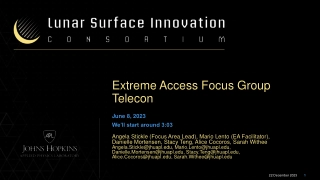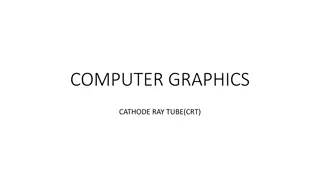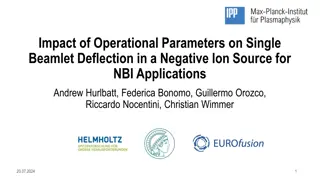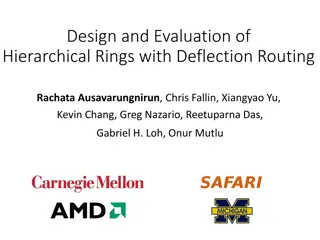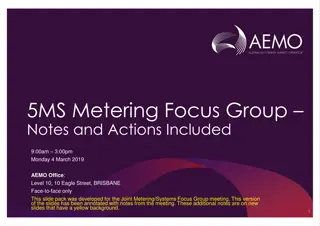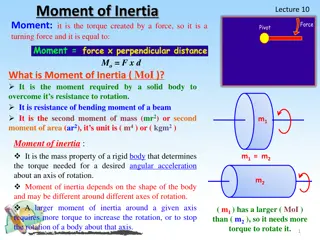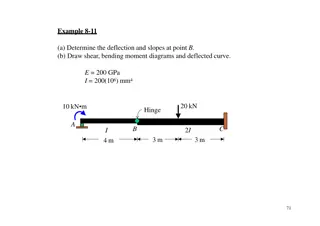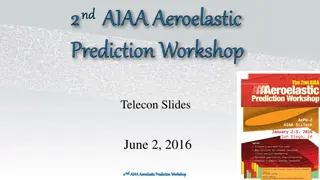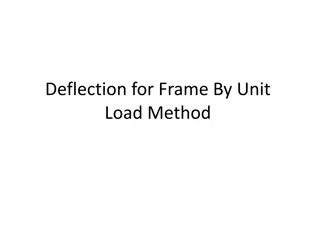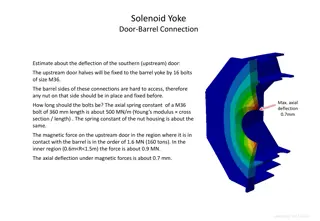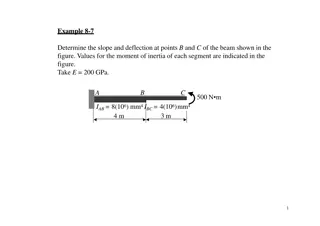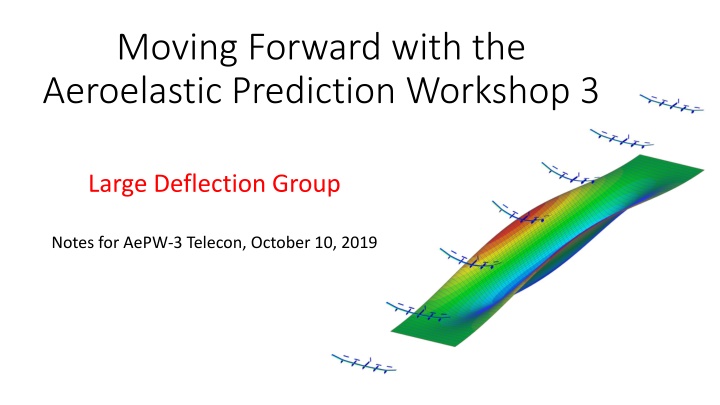
Aeroelastic Prediction Workshop 3 Large Deflection Group Update
Explore the latest developments in the Aeroelastic Prediction Workshop 3's Large Deflection Group, focusing on nonlinear aeroelasticity and its impact on structural deflections. Discover the goals, members, and ongoing projects of this innovative group.
Download Presentation

Please find below an Image/Link to download the presentation.
The content on the website is provided AS IS for your information and personal use only. It may not be sold, licensed, or shared on other websites without obtaining consent from the author. If you encounter any issues during the download, it is possible that the publisher has removed the file from their server.
You are allowed to download the files provided on this website for personal or commercial use, subject to the condition that they are used lawfully. All files are the property of their respective owners.
The content on the website is provided AS IS for your information and personal use only. It may not be sold, licensed, or shared on other websites without obtaining consent from the author.
E N D
Presentation Transcript
Moving Forward with the Aeroelastic Prediction Workshop 3 Large Deflection Group Notes for AePW-3 Telecon, October 10, 2019
Large Deflection Group: Members (mailing list as of October 2019) Member Facility Earl Dowell Duke University Kevin McHugh Duke University Maxim Freydin Duke University Kai Kruger Bastos Duke University Daniella Raveh Technion Moti Karpel Technion Arik Drachinsky Technion Rafael Palacios Imperial College Huub Timmermans NLR Jonathan Cooper University of Bristol Carlos Cesnik University of Michigan Roeland de Breuker TU Delft Jurij Sodja TU Delft Markus Zimmer DLR Johannes Dillinger DLR Markus Ritter DLR
Large Deflection Group: Organization A Large Deflection Group was launched within the community interested in a third Aeroelastic Prediction Workshop (AePW-3) This group will primarily focus on nonlinear aeroelasticity regarding large (nonlinear) structural deflections and their impact on the system The first Telecon of this group was held on September 25th: Motivations, topics, ideas, etc. were discussed and some test cases were presented The test cases from Duke University and Technion gained the most interest (see below) In the meanwhile, other configurations and a number of research topics centered around them were proposed and discussed via email The following slides show the currently most relevant experimental and simulation test cases
Duke University Aeroelastic Models Goals: Provide experimental data set to evaluate new nonlinear theoretical aeroelastic theories and computation methods Provide insights into nonlinear aeroelastic phenomena, such as flutter, LCO, and gust response High AR Wing Model: Made from steal spar and aluminum pieces/ribs (NACA 0012) with wood filling for aero shape Span 0.4508m, chord 0.0508m Slender body with masses to adjust torsional inertia to reduce natural torsional frequency Tests: Correlation studies for static aeroelastic response, flutter and LCO oscillations AePW benefits: Simple structural model Static and dynamic experimental data including LCOs Paper/Info: Tang and Dowell, Experimental Aeroelastic Models Design and Wind Tunnel Testing for Correlation with New Theory, Aerospace 2016
Technion Highly Flexible Wing Experimental Benchmark (in process) Goals: Generate a benchmark for static and dynamic (flutter) aeroelasticity of a very flexible wing. Will be used for validation of computational models and investigation of nonlinear aeroelastic phenomena. Gain experience with novel aeroelastic measurement techniques (optical fibers and motion tracking camera system) Model: Geometry: Chord - 100 mm, span - 550 mm Main spar: 550 X 60 X 2.5 mm, at the center-chord Airfoil - NACA0018, wing-tip rod for attaching weights Materials: Main spar - Aluminum 7075 Chassis - Nylon, PA12, 3D-printed Cover - Foil (Oralight, or the like) AePW benefits: Simple, low-cost design Can be shared and tested in several wind-tunnels FEM available (Ansys) Paper/Info: Avin et al., Design of an Experimental Benchmark of a Highly Flexible Wing, IACAS
University of Bristol High Aspect Ratio Wing Model (AWI-HARW) Goals: Explore static and dynamic aeroelastic behavior below flutter, but with LCOs due to geometric and aerodynamic nonlinearities Model: Semi-span = 2.4m, AR = 20, root chord = 320mm, taper ratio = 0.5 Aluminum alloy spar with foam sections and covering for aero shape Data sets: WT balance readings deflections from 3D Cameras strains and accelerations static pressures on one chordwise section unsteady pressures on one chordwise section Tests: Structural tests (including GVT) Static aeroelastic tests (max. tip deflection 25 % (w.r.t semi-span) Harmonic oscillations, push release Dynamic response with LCOs (in-plane bending and flow separation) Structural model/FEM? Paper/Info: Cooper et al., Wind Tunnel Testing of a High Aspect Ratio Wing Model, IFASD 2019
Interests and way forward Regarding these three test cases, we are interested in the investigation of several topics: Analysis of large static deflections (comparison of different theories and methods) Structural properties under preload due to large static deflection (changes in modal properties) Limits of linear methods (both structure and aero) Stability of the system about statically deformed aeroelastic shape (flutter, LCO) Hysteresis in LCO Impacts of nonlinear inertia effects on flutter/LCO (coupled in-plane and torsional motions at large deflections) Impact of aerodynamic nonlinearities (stall and flow separation at high AoA, low Reynolds numbers, necessity of high fidelity methods such as URANS) Interaction of aerodynamic and structural nonlinearities So far, most of us agreed to contribute to the Technion Benchmark Wing and the UoB AWI-HARW DLR and TU Delft offered to support collaborative experiments of the Technion Wing by testing this model in their wind tunnel (TU Delft would also do a GVT) There is also interest in flight dynamics of very flexible A/C, but this seems appropriate after the wing-only tests We will have another Telecon in the Large Deflection Group to decide upon the test cases we want to use and then develop a sequence of reasonable investigations

